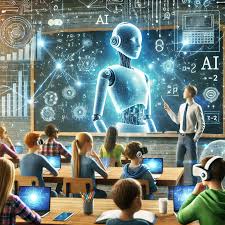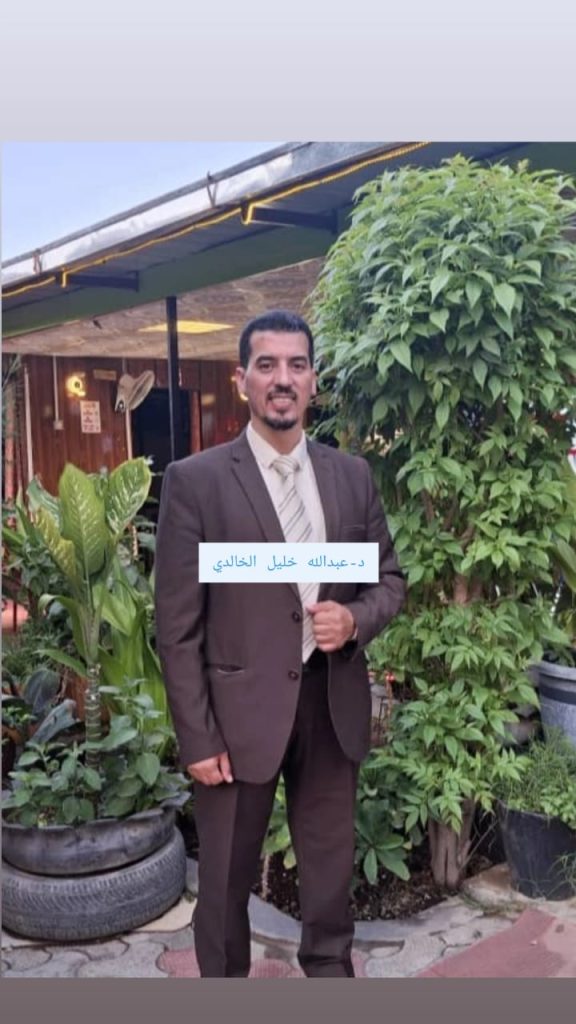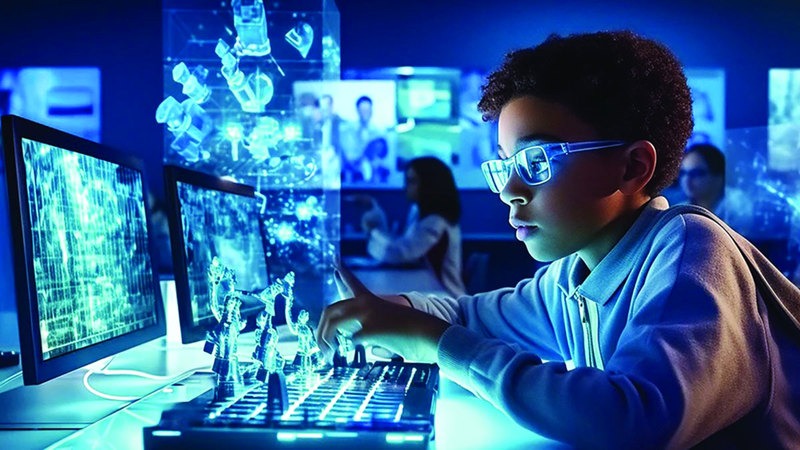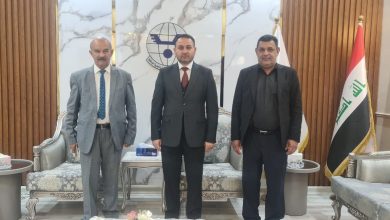بقلم دكتور عبدالله خليل الخالدي طبيب اسنان واستاذ باحث جامعي في جامعات الصومال كليات طب الاسنان.
التعليم بين الأمس واليوم: من قوالب الزمن الطويل إلى عصر الذكاء الاصطناعي التطوري الذاتي

 .
.
التعليم بين الأمس واليوم:
من قوالب الزمن الطويل إلى عصر الذكاء الاصطناعي التطوري الذاتي
#بقلم_دكتور_عبدالله_خليل_الخالدي
#طبيب_اسنان_واستاذ_باحث_جامعي #في_جامعات_الصومال
#كليات_طب_الاسنان.

ظلّ التعليم عبر التاريخ البشري الركيزة الأساسية لتكوين الحضارات وصناعة العقول. إلا أن صيغته كانت دائماً مرتبطة بأبعاد الزمان والمكان والأدوات المتاحة. في الماضي، كان الطالب يحتاج إلى سنوات طويلة، ومنهج تقليدي متدرج، وأدوات محدودة، ليصل في النهاية إلى شهادة أكاديمية تؤهله للعمل في مجاله. أما اليوم، فقد دخلنا عصراً جديداً من التعليم، حيث الذكاء الاصطناعي التطوري الذاتي (Self-Evolving AI) يقلب المفاهيم رأساً على عقب، ليطرح تساؤلات عميقة:
هل لا يزال المنهج الأكاديمي التقليدي قادراً على مجاراة إيقاع هذا الانفجار المعرفي؟ وهل ما زال نموذج الأربع سنوات في كلية الإدارة مثلاً، ضرورياً في ظل أدوات قادرة على تمكين المتعلم من محاكاة الخبرة البشرية بأشهر قليلة وربما أسابيع؟
#أولاً: التعليم التقليدي – رحلة عبر الزمن
1. عناصر التعليم الكلاسيكي
المنتَج (Product): الشهادة الأكاديمية باعتبارها الغاية النهائية.
الطريقة (Method): سلسلة متدرجة من المناهج والاختبارات.
الأدوات (Tools): كتب، محاضرات، سبورات، وأحياناً مختبرات بدائية.
الزمن (Time): سنوات طويلة من الدراسة الممرحلة.
2. الفلسفة الضمنية
ارتبط التعليم في السابق بفكرة أن المعرفة بناء تراكمي بطيء، وأن التخصص يستلزم تكريس سنوات لإتقان مفرداته. على سبيل المثال، دراسة الإدارة استغرقت أربع سنوات لتزويد الطالب بالمفاهيم الاقتصادية، السلوكية، والتطبيقية، بشكل يضمن التدرج المعرفي والانغماس العميق.
#ثانياً: التعليم في عصر الذكاء الاصطناعي التطوري الذاتي
1. كسر الحدود الزمنية
لم يعد الزمن معياراً حاسماً لاكتساب المعرفة. أدوات الذكاء الاصطناعي قادرة على تصميم خطط تعليمية شخصية (Personalized Curricula) تختصر سنوات التعلم في مسارات مكثفة، تتكيف مع قدرات المتعلم وسرعة استيعابه.
2. انتقال المعرفة من “المقرر” إلى “المهارة”
في السابق، كانت المعرفة مقرراً مغلقاً، أما اليوم فهي عملية مفتوحة ومستمرة. الذكاء الاصطناعي يقدم محتوى متجدد يتفاعل مع المتعلم لحظة بلحظة، محولاً التعليم من نقل معلومات إلى بناء مهارات فاعلة.
3. التعليم التكيفي (Adaptive Learning)
الخوارزميات تستطيع التعرف على نقاط قوة وضعف الطالب، وتقديم محتوى موجّه يعالج احتياجاته الخاصة، وهو ما لا يمكن لنظام القاعة التقليدية أن يوفره.
4. إلغاء الحواجز الجغرافية والمؤسسية
الطالب لم يعد بحاجة إلى كلية الإدارة التقليدية بأربع سنواتها المرهقة، بل يستطيع الوصول إلى أدوات ذكاء اصطناعي تجيب على استفساراته، تحاكي بيئات الأعمال الحقيقية، وتدربه على اتخاذ القرار عبر المحاكاة التفاعلية.
#ثالثاً: نحو مستقبل التعليم – ما الذي يخبئه الغد؟
1. التحول من “الشهادة” إلى “الكفاءة”
المستقبل لن يقيس قيمة المتعلم بعدد السنوات التي قضاها، بل بمدى قدرته على إثبات مهاراته مباشرة في بيئة العمل.
2. المناهج الديناميكية
سيصبح المنهج التعليمي كائناً حياً يتطور لحظة بلحظة مع تطور العلوم والتكنولوجيا، لا كتاباً جامداً يظل ثابتاً لعقود.
3. الشراكة بين الإنسان والآلة
المعلم لن يختفي، لكنه سيتحول إلى موجّه استراتيجي يعمل جنباً إلى جنب مع أدوات الذكاء الاصطناعي لتقديم تجربة تعليمية أكثر ثراءً.
4. توقعات التحولات الكبرى
قد تختفي بعض التخصصات التقليدية أو تندمج.
شهادات “الأربع سنوات” قد تصبح من الماضي لصالح برامج قصيرة مكثفة.
الجامعات ستتحول إلى مراكز ابتكار، لا مجرد مؤسسات تدريسية.
#رابعاً: التحديات الأخلاقية والمعرفية
1. التفاوت الاجتماعي الرقمي: هل يستطيع الجميع الوصول إلى أدوات الذكاء الاصطناعي؟
2. الهوية المعرفية للإنسان: إذا كان الذكاء الاصطناعي قادراً على التعليم والتقييم، فما الذي يميز المتعلم البشري؟
3. المسؤولية الأكاديمية: من يضع المناهج؟ ومن يضمن مصداقية المحتوى؟
الخاتمة
بين الماضي والحاضر، يقف التعليم اليوم على أعتاب ثورة غير مسبوقة. إذا كان التعليم التقليدي قد شكّل أساس الحضارات عبر الزمن، فإن التعليم في عصر الذكاء الاصطناعي التطوري الذاتي يفتح الباب أمام تحرر كامل من قيود الزمان والمكان.
لم تعد القضية مرتبطة فقط بعدد السنوات أو الكتب المقررة، بل بقدرة المتعلم على الدخول في رحلة مستمرة من التطوير الذاتي، مدعوماً بشريك معرفي جديد: الذكاء الاصطناعي. والسؤال الأعمق الذي يواجهنا اليوم ليس: هل نحتاج أربع سنوات لدراسة الإدارة؟ بل: كيف نصوغ تعليماً يجعل الفرد قادراً على التكيف مع عالم يتغير كل أربع دقائق؟
إننا أمام لحظة تاريخية فارقة: إما أن نبقى أسرى نماذج الماضي، أو أن نتبنى رؤية مستقبلية تجعل التعليم عملية مستمرة، ديناميكية، ومرنة، يقودها الإنسان وتغذيها قوة الذكاء الاصطناعي.
Education Yesterday and Today:
From Long-Term Frameworks to the Era of Self-Evolving Artificial Intelligence
By: Dr. Abdullah Khalil Al-Khalidi
Introduction
Throughout human history, education has remained a cornerstone for building civilizations and shaping minds. Yet, its traditional format has always been tied to the constraints of time, place, and available tools. In the past, students required many years, a stepwise traditional curriculum, and limited resources to ultimately obtain an academic degree qualifying them for their field of work. Today, however, we have entered a new era of education, where Self-Evolving Artificial Intelligence (Self-Evolving AI) turns traditional concepts upside down, raising profound questions:
Can the conventional academic curriculum still keep pace with the rapid explosion of knowledge? Is the four-year model in business schools, for example, still necessary in light of tools that can enable learners to simulate human experience in just a few months—or even weeks?
I. Traditional Education – A Journey Through Time
1. Elements of Classical Education
Product: The academic degree as the ultimate goal.
Method: A sequential series of curricula and assessments.
Tools: Books, lectures, blackboards, and sometimes rudimentary laboratories.
Time: Several long years of phased study.
2. Implicit Philosophy
Traditional education was based on the idea that knowledge is a slow, cumulative construct, and specialization requires years of dedication to master its components. For example, studying management traditionally took four years to provide students with economic, behavioral, and practical concepts in a structured and immersive way.
II. Education in the Era of Self-Evolving Artificial Intelligence
1. Breaking Temporal Boundaries
Time is no longer the critical determinant for acquiring knowledge. AI tools can design personalized curricula that condense years of study into intensive learning paths, adapting to the learner’s capabilities and pace of understanding.
2. Transitioning from “Curriculum” to “Skill”
Previously, knowledge was confined to a fixed curriculum. Today, it is an open and continuous process. AI delivers updated content that interacts with the learner moment by moment, transforming education from mere information transfer into active skill-building.
3. Adaptive Learning
Algorithms can identify a student’s strengths and weaknesses and provide targeted content to address specific needs—a capability that traditional classroom systems cannot match.
4. Removing Geographic and Institutional Barriers
Students no longer need the traditional four-year business school model. Instead, they can access AI tools that answer questions, simulate real-world business environments, and train decision-making skills through interactive simulations.
III. Towards the Future of Education – What Lies Ahead?
1. Shifting from “Degree” to “Competence”
The future will measure a learner’s value not by the number of years spent, but by their ability to demonstrate skills directly in the workplace.
2. Dynamic Curricula
Curricula will become living entities, evolving in real time alongside scientific and technological advances, rather than static texts fixed for decades.
3. Human-AI Partnership
Teachers will not disappear; they will transform into strategic guides, working alongside AI tools to provide richer educational experiences.
4. Anticipated Major Transformations
Some traditional disciplines may disappear or merge.
Four-year degrees could be replaced by intensive short programs.
Universities will become centers of innovation rather than mere teaching institutions.
IV. Ethical and Epistemological Challenges
1. Digital Social Inequality: Can everyone access AI tools?
2. Human Knowledge Identity: If AI can teach and evaluate, what distinguishes the human learner?
3. Academic Responsibility: Who sets the curricula? Who ensures the credibility of the content?
Conclusion
Between past and present, education today stands at the threshold of an unprecedented revolution. While traditional education has historically shaped civilizations, education in the era of self-evolving AI opens the door to complete liberation from the constraints of time and place.
The issue is no longer merely the number of years or textbooks, but the learner’s ability to embark on a continuous journey of self-development, supported by a new cognitive partner: AI. The deeper question we face today is not: Do we need four years to study management? Rather, it is: How do we design education that equips individuals to adapt in a world that changes every four minutes?
We are at a pivotal historical moment: either remain bound by past models, or embrace a visionary future where education is continuous, dynamic, and flexible—guided by humans and fueled by the power of AI.
المراجع
Ally, M. (2019). Competency profile of the digital and online teacher in future education. The International Review of Research in Open and Distributed Learning, 20(2), 302–318. https://doi.org/10.19173/irrodl.v20i2.4206
Brynjolfsson, E., & McAfee, A. (2017). Machine, platform, crowd: Harnessing our digital future. W. W. Norton & Company.
Holmes, W., Bialik, M., & Fadel, C. (2019). Artificial intelligence in education: Promises and implications for teaching and learning. Center for Curriculum Redesign.
Luckin, R., Holmes, W., Griffiths, M., & Forcier, L. B. (2016). Intelligence unleashed: An argument for AI in education. Pearson Education.
Popenici, S. A. D., & Kerr, S. (2017). Exploring the impact of artificial intelligence on teaching and learning in higher education. Research and Practice in Technology Enhanced Learning, 12(1), 1–13. https://doi.org/10.1186/s41039-017-0062-8
Selwyn, N. (2019). Should robots replace teachers? AI and the future of education. Polity Press.
Siemens, G. (2013). Learning analytics: The emergence of a discipline. American Behavioral Scientist, 57(10), 1380–1400. https://doi.org/10.1177/0002764213498851
UNESCO. (2021). AI and education: Guidance for policy-makers. UNESCO Publishing.




